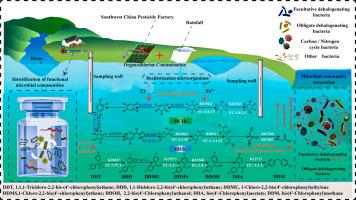纳米级零价铁与微生物耦合增强地下水中有机氯农药的去除:来自级联效应和水平基因转移作用的见解
IF 12.4
1区 环境科学与生态学
Q1 ENGINEERING, ENVIRONMENTAL
引用次数: 0
摘要
纳米级零价铁(nZVIs)是一种很有前途的修复有机氯污染地下水的方法。然而,nZVIs与本地脱氯微生物之间的相互作用是复杂的,可能对有机氯的脱氯产生不可预测的影响,需要进一步研究。本研究以西南某废弃农药工厂为研究对象,结合微观实验重构生物脱氯代谢途径,量化脱氯基因和微生物的功能贡献。结果表明,微生物与nZVIs联合处理显著提高了HCHs、DDTs及其6种异构体的降解效率,HCHs的去除率高达99%,DDTs的去除率高达87.73%。Cl -⁻和Fe 2⁺的浓度对携带HCHs降解基因的微生物群落的富集有直接的积极影响。由dhaA基因编码的卤烷脱卤酶被认为是降解β-HCH前体的关键酶,它不仅促进兼性脱卤体(尤其是Acidovorax和methylomultilis)的生长,而且提高了整体脱氯活性。重要的是,我们成功地重建了7个携带dhaA基因的近乎完整的细菌宏基因组组装基因组(MAGs),代表了分类上多样化的新型脱氯微生物。此外,nZVIs显著增加了移动遗传元件(MGEs)的丰度,在7个mag中含有dhaA的支架中检测到17个MGEs。整合酶和转座酶被确定为促进dhaA传播的关键驱动因素。这一发现得到了携带dhaA的宿主的转移,以及在基因组树和dhaA蛋白系统发育树之间观察到的不一致的进化模式的支持。具体来说,级联效应和水平基因转移协同促进了脱氯微生物的增殖,为有机氯污染生态系统的管理和修复提供了新的策略。本文章由计算机程序翻译,如有差异,请以英文原文为准。

Nanoscale zero-valent iron coupled with microorganisms enhances the removal of organochlorine pesticides in groundwater: Insights from the role of cascading effects and horizontal gene transfer
Nanoscale zero-valent iron (nZVIs) represent a promising approach for the remediation of organic chlorine-contaminated groundwater. However, the interaction between nZVIs and indigenous dechlorinating microorganisms is complex, which may have unpredictable effects on the dechlorination of organic chlorine, necessitating further investigation. In this study, we investigated an abandoned pesticide factory in southwest China, combined with microcosm experiment to reconstruct the metabolic pathway of biological dechlorination, and quantified the functional contribution of dechlorination genes and microorganisms. The results showed that the combined treatment of nZVIs and microorganisms significantly enhanced the degradation efficiency of HCHs, DDTs, and their six isomers, achieving removal rates of up to 99% for HCHs and 87.73% for DDTs. The concentrations of Cl⁻ and Fe²⁺ had a direct positive effect on the enrichment of microbial communities harboring HCHs degradation genes. Haloalkane dehalogenase encoded by the dhaA gene was identified as a key enzyme in the degradation of β-HCH precursors, which not only promoted the growth of facultative dehalogenators (particularly Acidovorax and Methyloversatilis) but also enhanced overall dechlorination activity. Importantly, we successfully reconstructed 7 near-complete bacterial metagenome-assembled genomes (MAGs) carrying the dhaA gene, representing taxonomically diverse novel dechlorinating microorganisms. Additionally, nZVIs significantly increased the abundance of mobile genetic elements (MGEs), with 17 MGEs detected within scaffolds harboring dhaA in the 7 MAGs. Integrases and transposases were identified as key drivers facilitating the spread of dhaA. This finding was supported by the shift of dhaA-harboring hosts, and by the incongruent evolutionary patterns observed between the genome-based tree and the dhaA protein phylogenetic tree. To be specific, cascading effects and horizontal gene transfer synergistically promoted the proliferation of dechlorinating microbes, providing novel strategies for managing and remediating organic chlorine-contaminated ecosystems.
求助全文
通过发布文献求助,成功后即可免费获取论文全文。
去求助
来源期刊

Water Research
环境科学-工程:环境
CiteScore
20.80
自引率
9.40%
发文量
1307
审稿时长
38 days
期刊介绍:
Water Research, along with its open access companion journal Water Research X, serves as a platform for publishing original research papers covering various aspects of the science and technology related to the anthropogenic water cycle, water quality, and its management worldwide. The audience targeted by the journal comprises biologists, chemical engineers, chemists, civil engineers, environmental engineers, limnologists, and microbiologists. The scope of the journal include:
•Treatment processes for water and wastewaters (municipal, agricultural, industrial, and on-site treatment), including resource recovery and residuals management;
•Urban hydrology including sewer systems, stormwater management, and green infrastructure;
•Drinking water treatment and distribution;
•Potable and non-potable water reuse;
•Sanitation, public health, and risk assessment;
•Anaerobic digestion, solid and hazardous waste management, including source characterization and the effects and control of leachates and gaseous emissions;
•Contaminants (chemical, microbial, anthropogenic particles such as nanoparticles or microplastics) and related water quality sensing, monitoring, fate, and assessment;
•Anthropogenic impacts on inland, tidal, coastal and urban waters, focusing on surface and ground waters, and point and non-point sources of pollution;
•Environmental restoration, linked to surface water, groundwater and groundwater remediation;
•Analysis of the interfaces between sediments and water, and between water and atmosphere, focusing specifically on anthropogenic impacts;
•Mathematical modelling, systems analysis, machine learning, and beneficial use of big data related to the anthropogenic water cycle;
•Socio-economic, policy, and regulations studies.
 求助内容:
求助内容: 应助结果提醒方式:
应助结果提醒方式:


